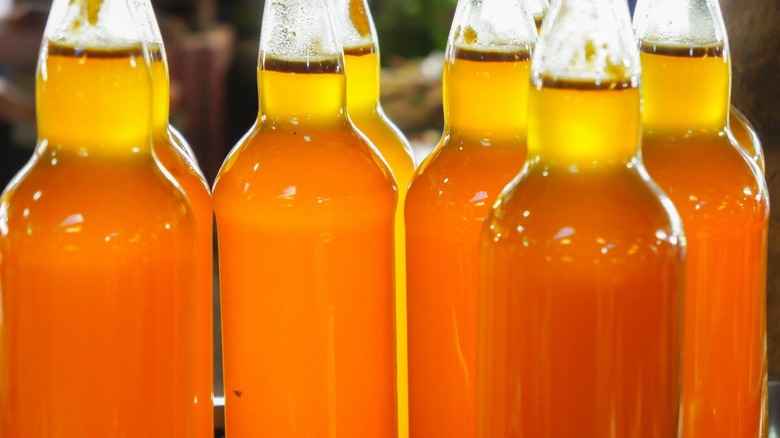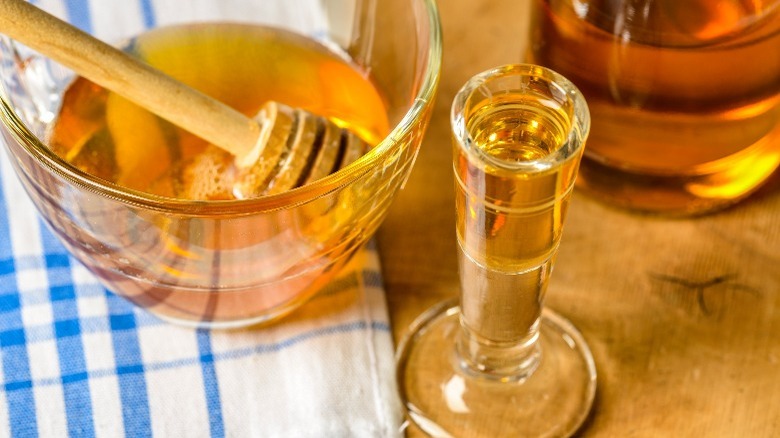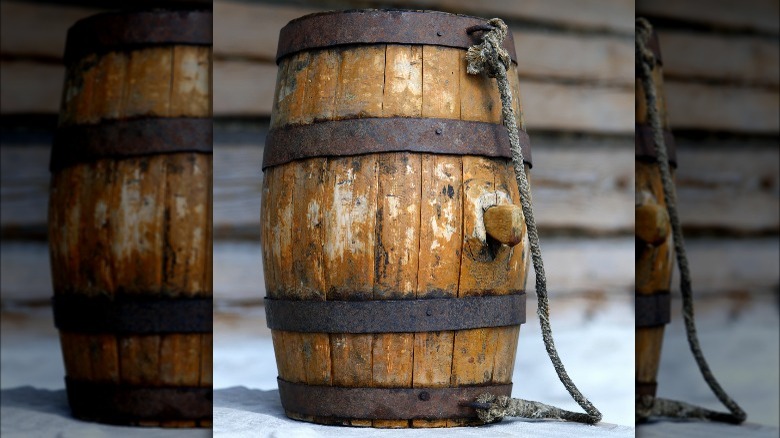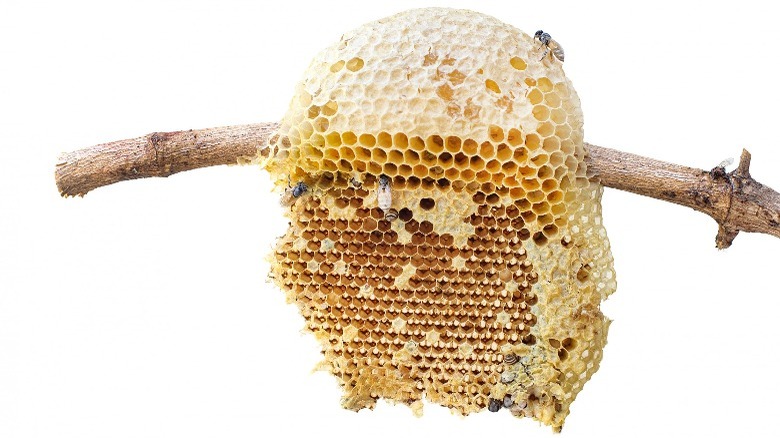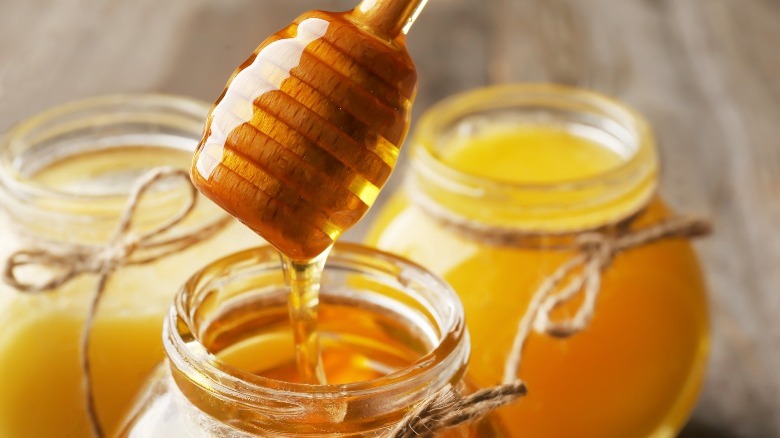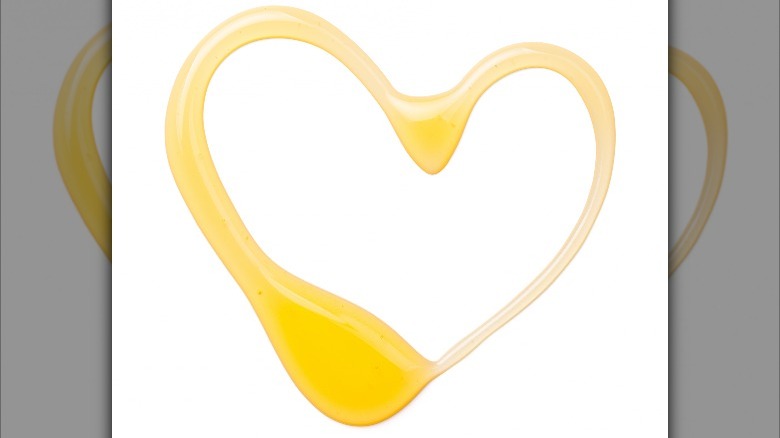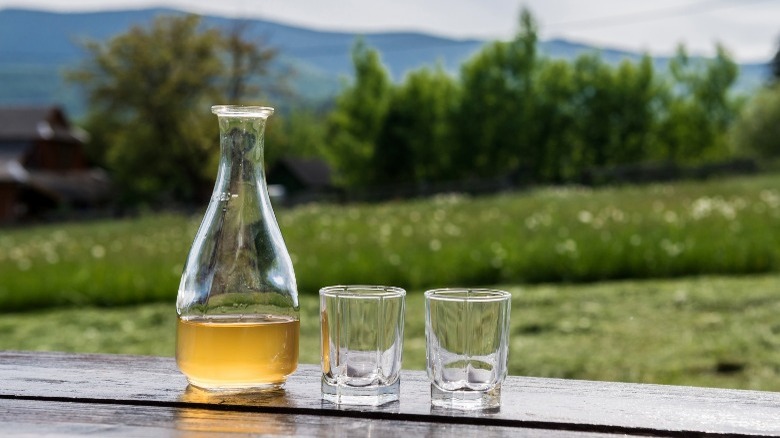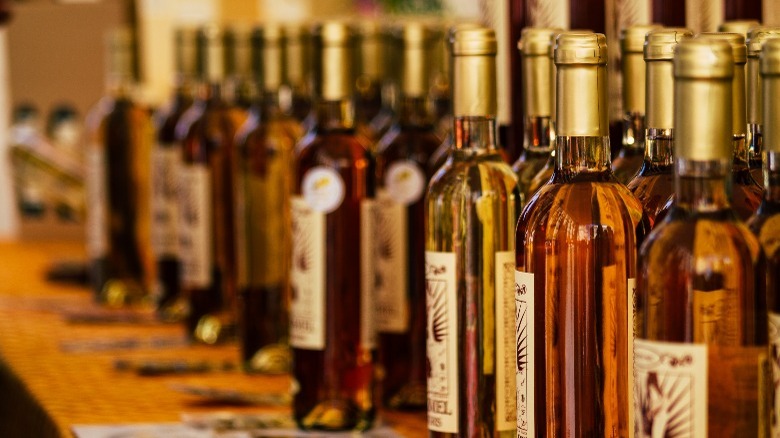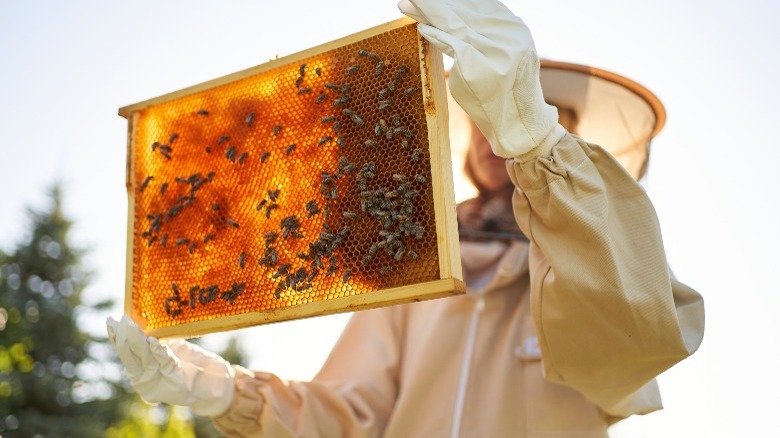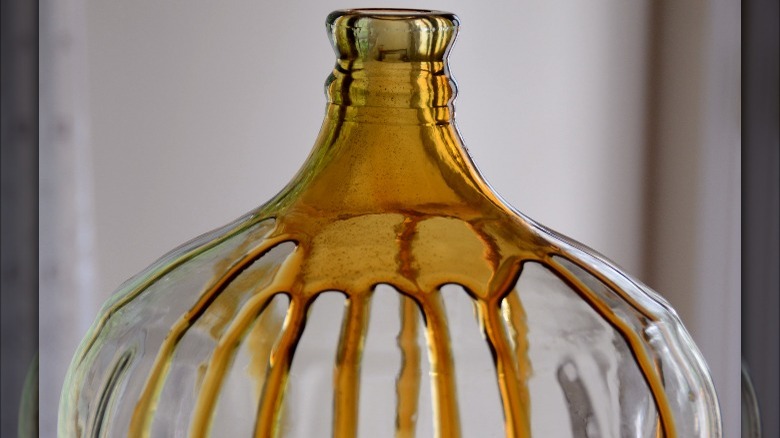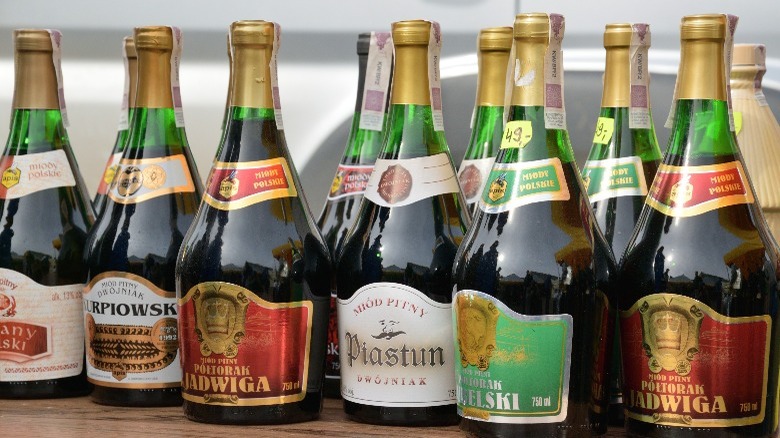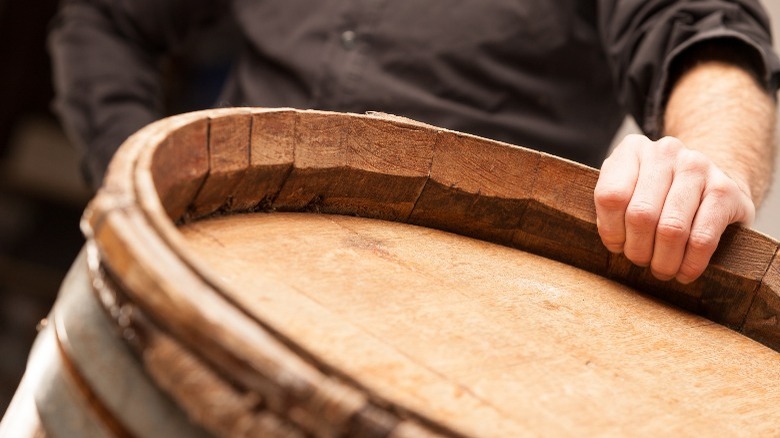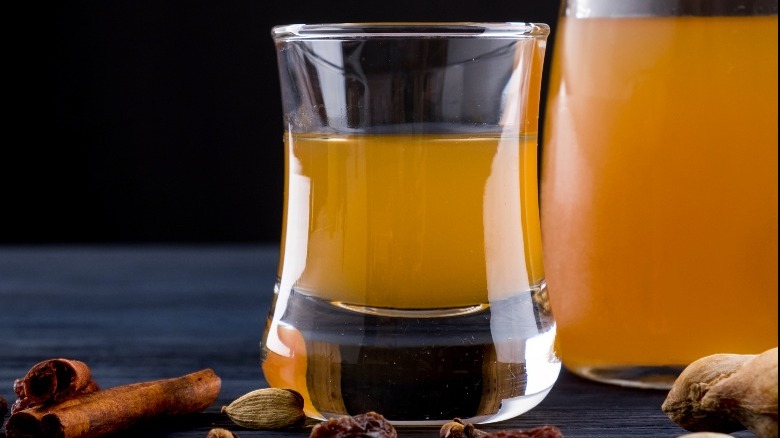What You Need To Know Before Taking Another Sip Of Mead
Many know mead as the ancient beverage referenced in their favorite piece of medieval entertainment. While enjoying these period pieces, we sometimes come across a group of smelly-looking travelers crowded inside a dingy pub. If the story is authentic, mead might be this group's drink of choice. While it's fun to experience, the scene doesn't make you the least bit thirsty. Rather, it might make you pity the motley crew's lack of White Claws.
But somehow, mead has successfully reinvented itself in the food world. Once the drink entered contemporary society, it found a fan base not only among the average Renaissance festival attendee, but also within the craft alcoholic beverage communities.
The reason for mead's success today could be its nostalgic qualities — similar to popular "eat like your ancestors" fads such as the paleo diet — but not completely. Instead, brewers' and drinkers' interest in mead also seems to stem from the drink's inherent properties: being made from honey and what that means for producing it. In the end, there's a lot to learn about this drink. Here's what you need to know before taking another sip of mead.
Honey is the key ingredient
According to Britannica, mead has existed since roughly 600 B.C.E. The drink was made of the same ingredients, even back then. Honey, water, and (sometimes) yeast are the only items required to make this ancient drink. Yeast can help with the fermentation process, but honey and water can also do it alone. However, sometimes this natural brewing process can take several weeks or months until your beverage is drinkable, even with the addition of yeast (via The Good Life Revival).
As BBC Good Food explains, "The defining characteristic of mead is that the main source of its fermentable sugar comes from honey." All drinks looking to be classified as mead need at least 51% of this sugar to be honey-based (via The Crafty Cask). As mead ferments, these sugars become alcohol. The process is akin to what happens when brewing other alcoholic beverages. There's sugar in the apples used to make cider, the malted barley used to make beer, and the grapes used to make wine, explains Alcohol.org. Just how honey provides the sugar for mead, the sugar in other natural ingredients eventually ferments, turning all of these drinks alcoholic.
It's one of the oldest forms of booze
Evidence of very old recipes for mead exists all over the world. Typically, the drink is known for its European associations. The Scottish, English, and Scandinavian peoples have long been connected to mead — hence the many references among talk of knights and Vikings. In the United Kingdom in particular, where Scottish meaderies like The Rookery still produce the drink today, there's evidence of mead production beginning 5,000 years ago.
However, China may have been the first country to ever produce it. A recipe for making the drink from honey, rice, water, and yeast is typically cited as the oldest mead formula, according to Vogue. This method from the country's Henan province dates back to the seventh millennium B.C.E. Other non-Western regions are sometimes overlooked in the discussion of mead's history. But across parts of Africa and Asia, mead has been made for centuries, sometimes even millennia (via NPR).
A flooded beehive may have invented it
There's another, more unofficial story that mead fans like to say is responsible for the drink's origins. The story goes that a group of "hunter-gatherers" came across an upturned beehive filled with rainwater, according to Mead in New Zealand. Somehow, the finders drank this liquid without getting stung by (or swallowing) any dead bees. Upon drinking the sweet mead, they "experienced the first intoxication." These hunters couldn't get enough of it after that. They likely began attempting to replicate the sweet rainwater throughout their own brewing processes. Thus, the first batch of mead was made.
The truth may be lacking from this myth, but many like to tell it as it captures the simplicity of the drink. In truth, there's little evidence to tell exactly how old mead is, since the first mead recipes likely predate written history, explains Mad Alche Mead. So how do we know the ancients were making mead at all? Even before the Vikings and the Knights? There are ancient cave paintings depicting honey collection, along with other archeological evidence pointing to the fermentation of this old beverage.
Vikings called it The nectar of the gods
The hedonistic Vikings are usually portrayed enjoying this alcoholic beverage. The mead they were known to drink (via Norse Mythology) no doubt added to the fun of their bloodthirsty attacks. However, these Scandinavian warriors were likely inspired by their religion to drink it. In Norse mythology, the God Odin "gained his strength because he drank mead as a suckling baby," according to Tech Times. The Vikings also thought if they were killed in battle, they would earn a place in a special section of Viking heaven called Valhalla (via Vikings.com). There, they'd be welcomed to this VIP section of the afterlife with glasses of mead.
Due to its associations with Norse gods and Viking immortality (as well as the fact that honey comes from plant nectar), the Vikings called mead "the nectar of the gods." Although lesser-known, the Greeks and Romans — who lived before the Vikings — may have originally come up with this phrase, explains Batch Mead. The Greek god Bacchus was initially referred to as the "God of Mead" rather than the "God of Wine." The Romans served mead at their parties. The Greeks even believed that mead was drunk on Mt. Olympus — the home of the Greek mythological gods (via Batch Mead). Whoever came up with this catchphrase, many ancient peoples clearly thought mead to be a godly drink.
Queen Elizabeth and other royals drank it
A little later down the historical timeline, the royals started to enjoy mead. Queen Elizabeth I, the daughter of Henry VIII and Anne Boleyn, is particularly known for her love of mead. The queen took the throne at the young age of 25 in 1559, where she was known for her successful ruling years as the unmarried "Virgin Queen," according to Royal.U.K. But before becoming Queen, she had her own private manor where she was renowned for her "gastronomic talents" (via Epicurus) and "was known to have been quite the wiz in the kitchen" (via Ale Horn).
Queen Elizabeth's mead recipe is preserved today. The recipe is not a particularly ingenious creation — as mead had long been popular before the mid-1500s — but it shows an interesting mead recipe from "The Golden Age" of England. Elizabeth's favorite mead was a herbal mead filled with ingredients like rosemary, thyme, sweet briar, bay leaves, and sometimes other botanicals, explains Beer Recipes. You can make Queen Elizabeth I's mead today. Be prepared to wait one full year until fermentation is finished and your drink is ready to be drunk.
Classic literature loves to name-drop it
Mead is found in literature throughout history. Sometimes it's included in texts so old that mead was — at the time — still everyone's favorite booze. In Beowulf, written between 700 and 1000 A.D., the text's anonymous author says, "I have never seen mead enjoyed more in any hall on earth," (via Meadist).
Fyodor Dostoyevsky's "The Brothers Karamazov," published in 1879, includes a reference to mead in a decadent dining description. Dostoyevsky wrote, "but the most sumptuous thing in the room at that moment was naturally the sumptuously laid table ... two bottles of wine, two bottles of excellent monastery mead, and a large glass jug of monastery kvass" (via Goodreads). A similar description of mead occurs in Leo Tolstoy's "War and Peace," where he writes, "On the tray was a bottle of herb wine, different kinds of vodka ... still mead and sparkling mead," (via Literature Page). The books were published around the same time, with War and Peace being released in 1869 (via New York Times).
Even in more modern books, mead continues to appear. In 20th century novels, it was used to invoke another, more historic time. In "The Hobbit," published in 1932, author J.R.R. Tolkien writes, "They sat long at the table with their wooden drinking bowls filled with mead." In the same author's later book published in the 1950s, "The Fellowship of the Ring," Tolkien includes the epic line, "The years have passed like swift draughts of sweet mead in lofty halls beyond the West."
It is found in pop culture, from Game of Thrones to Harry Potter
If you've read the "Harry Potter" series or seen the film franchise, you might remember Hogsmeade. The fictional town located near Hogwarts is where Harry, Ron, Hermoine, and their classmates go during their teen years on school weekends. "Mead" is not only in the name of this town, but is sold at the town's bar: The Three Broomsticks (via Harry Potter Wiki). In the third novel, the character Hagrid goes to the bar and orders four pints of "mulled mead" for himself, according to Harry Potter Wiki. In the sixth book, Ron is also accidentally sickened from drinking a poisoned "oak-aged mead" meant for Dumbledore.
Mead is also referenced throughout the "Game of Thrones" television show, as well as "The Song of Ice and Fire" books which it is based on. According to A Wiki of Ice and Fire, the tradition of "mead and meat" is popular throughout the "Game of Thrones" world. In the sixth season, the following quote features the importance of this tradition: "And I vow, that you shall always have a place by my hearth, and meat and mead at my table..." (via Ale Horn). Both the "Harry Potter" and "Game of Thrones" mead references help to build the magical, medieval worlds in which these stories take place.
Drinking it may have potential health benefits
As we've previously mentioned, the sugar in mead comes from honey. Honey is sometimes thought of as a health food. That's due to it containing useful nutrients like iron, potassium, calcium, and magnesium. Ingesting honey is also a way to get some of the recommended B1, B2, B3, and C vitamins. All of these things have given honey its reputation as a food with anti-inflammatory, antibacterial, and antioxidant properties. On the downside, there's also a lot of sugar in honey — sometimes even more grams per tablespoon than in more processed sugar alternatives. But does honey bring all these benefits (and some drawbacks) to mead?
We know that ancestors thought drinking mead would make them "godlike." However, it's possible that once they started doing this, they started noticing certain health benefits from the drink. In turn, these health benefits began to make them feel godlike. A mead expert told Business Insider it's likely some of these benefits were authentic, as the antibiotic properties of honey remained in mead, helping ancient warriors who drank it to fight infection if wounded in battle. Hidden Legend Winery echoed that mead's main health benefit is typically thought of as the drink's ability to fight disease. Additionally, the alcoholic beverage may help with digestion and stress relief. So in fact, it does seem that drinking mead allows you to get some of honey's natural health remedies.
Since it's an aphrodisiac, it possibly inspired the word Honeymoon
Among honey's health benefits, there's one property that sometimes gets overlooked. Honey is an aphrodisiac. It contains boron, a chemical that impacts the body's regulation of hormones such as estrogen and testosterone. A small amount of nitric oxide, which is released during arousal, is also in honey (via Asheville Bee Charmer). Since honey's other health benefits can be reaped through drinking mead, the syrup could also increase one's libido (slightly) as well. In turn, mead could be a little bit of an aphrodisiac.
Mead's potential as a love potion may even have historical significance. The drink is the reason for the word "honeymoon." You may know the term as what describes the time after a wedding, but mead is tied to the expression's first uses. According to Monks Meadery, new couples were "given a supply of mead" to accompany them on their post-marriage vacations. Couples were told to drink mead, as an aphrodisiac, daily to increase the probability of pregnancy, and help them to start a family. The amount of time that couples were away drinking mead was typically one month — a full lunar cycle — which gave rise to the "moon" part of the word, reports Brides.
Honey wine doesn't always mean the same thing
On your quest to learn about mead, you may hear the term "honey wine" being thrown around. Do not be mistaken — this term is a misnomer. Mead is never made from grapes, which is the definition of wine, according to Merriam-Webster. However, you may come across a bottle labeled "honey wine" that is, in fact, mead. The reason for this is likely labeling issues in the United States. The problem comes from the Alcohol & Tobacco Tax and Trade Bureau. For years, this organization required mead to be bottled with the phrase "honey wine," reports Sound Brewery. Additionally, the Federal Alcohol Administration Act regulates mead as if it were wine. Meaderies are even required to obtain a winery license to start selling their mead (via Hops and Vine).
That's not always the case anymore. There should be plenty of U.S. bottles with the word "mead" on them to choose from. But there are also some instances when honey wine does not refer to mead, but a different beverage. T'ej, a type of alcoholic Ethiopian beverage, is often referred to as "honey wine" (via Well Preserved). But unlike mead, which requires at least 51% of the sugars to come from honey, only about 20% or less honey is used in brewing T'ej. Overall, just make sure to read a little bit of the label when you're picking out a bottle of mead.
Its ABV is typically similar to beer, but it can vary
Most meads have an ABV between 3 and 20%. Meads on the lower end of the spectrum may be newer, according to Meadiocrity Mead, because previously most bottles of the drink had an ABV over 10%. The drink is divided into categories today, based on how much alcohol it has. Hydromel (or session) meads have an ABV between 3.5 and 7.5%, standard meads have an ABV between 7.5 and 14%, and sack meads have an ABV greater than 14%, reports Mead Makr.
Due to the large range in ABV — depending on the type of mead you're drinking — it's hard to compare mead's alcohol content to that of similar beverages. A beer's average ABV is 4.5% and a wine's average ABV is 11.6% (via Mashed). Mead could be closer to either, depending on whether you have a session mead or a sack mead.
Some individuals will tend to insist on comparing mead to either beer or wine. The medieval beverage is fermented in a process similar to beer. It's also regulated with rules similar to wine, given the aforementioned mixup with "honey wine." But regardless of these fruitless comparisons, most people will tell you that mead "exists in a category all its own." With that in mind, it's recommended to learn more about the particular batch of mead you're sipping — before you order another pint.
It's usually more expensive than beer, wine, or cider
While mead can be similar in ABV to beers, wines, or even ciders, it's likely going to be far more expensive than all of them. According to Viking Alchemist, "A good mead will be priced in the $20-30 range." The reason for the higher bottle cost is honey. As Advertising Grow explains, the high cost of honey is often attributed to the difficulties in gathering it. It's not hard to understand that picking apples from a tree for cider is easier than collecting honey from a beehive for mead — one harvesting process could leave you covered in stings.
Along with the risk of injury, any time animals are involved in agriculture there's probably going to be a range in how those animals are treated in making food products. As a result, there's a range in ethical practices used for beekeeping (via Circling Hawk Farm). There's a range in how many of these practices will be adopted by companies. Finally, those practices could impact the cost of each mead even more.
To add to that, making even a small amount of mead sometimes requires several gallons of honey. A pound of honey worldwide averaged around $4 in 2019 (via Mashed). In the years since that report, prices have only gone up. With several pounds of honey required to make mead, you can see how the beverage's production costs quickly increase.
Rising honey costs contribute to higher mead prices
There's another reason why mead prices may be higher than you expect — the rising cost of honey. According to a Wall Street Journal report from 2019, sugar prices fell by 30% between 2013 and 2019, while honey prices rose by 25% in the same period. In May 2019, worldwide prices of honey were around $4 per pound, and costs in the United States were even higher. Back then, American honey was priced around $7 per pound. Keep in mind, the teddy bear-shaped honey bottle only contains 12 ounces, which is less than a pound, (via Bear Country Bees), so the prices you see in stores may not line up exactly. However, if you think you noticed those bears are getting more expensive, you might be right.
Since 2019, the price of honey has been impacted by the COVID-19 pandemic even more. Shifting weather patterns and supply chain issues have caused shortages in the States (via BeeCulture). However, it seems all of those factors have only driven up the price of honey even more. All of these price-increasing honey challenges can increase the cost of mead production, thereby increasing the cost of your mead.
You can legally brew your own
One way to avoid fluctuating prices could be to make your own. Yes, it is legal to brew mead in America. Plus, as long as you're not selling it, there's a bunch of rules put forth by the Alcohol and Tobacco Tax and Trade Bureau that you can avoid (via TTB).
According to Almost Off Grid, there are endless mead recipes to try, which can be daunting. However, there are a few ways to avoid failure right off the bat. First, make sure that your honey is quality. You can do this by looking for a respected beekeeper near you and buying honey directly from them — because you're going to need a lot! Next, make the effort to sterilize all your brewing equipment. These few steps will help your mead-making process run more smoothly.
The ingredients for mead brewing are simple enough. In addition to honey and water, you'll want yeast (look for some labeled "mead yeast," not the kind you use to bake bread), explains Epicurious. But the equipment is a little more niche. Maybe the rarest of the appliance list — like this one from Grow Forage Cook Ferment — is a gallon-sized glass jug topped with an airlock and rubber stopper. This is especially important because it's where your mead will spend weeks to months, maybe even years, fermenting. If you can stand the wait and are inspired to do so, go ahead and start preparing to make that first batch.
There are several different types
In addition to the different names for meads by alcohol content (hydromel/session, standard, and sack) there are other ways to classify mead. Per Beacon Mead, one of those categories is the aging period. If you're looking for an older mead, select a bottle labeled "long mead." If you're making a mead without a lot of time to kill, look for recipes titled "quick mead." Mead can also go by different names depending on where in the world it's found. For example, mead in Mexico is sometimes called "Acan" and mead in Finland is sometimes called "Sima," explains Home Stratosphere.
There are about 20 common kinds of mead that categorize themselves based on ingredients used. All of the meads will still contain honey, water, and likely yeast. However, these meads will also have specific things added to them, or certain processes employed, that define each.
According to Batch Mead, some of these mead categories are: Acerglyn (contains maple syrup), Braggot (contains barley malt), Bochet (contains caramelized honey), Capsicumel (contains chile peppers), Cyser (contains apples), Hippocras (contains botanicals and spices), Metheglin (contains spices, occasional fruit), Morat (contains mulberries), Omphacomel (contains "juice from unripened grapes"), Oxymel (contains vinegar), Pyment (contains grapes), and Rhodomel (contains rose hips or rose petals).
A popularity surge paralleled the craft beer movement
Although it kind of took hundreds of years — when tax laws and sugar availability caused the drink to fall out of favor — mead is finally becoming more popular again. The beverage started experiencing a Renaissance of sorts during the early 2010s. According to Meadist, the mead industry was the fastest-growing alcohol sector in 2014. By 2016, the number of meaderies in the United States had grown to 300, from just 30 in 2003 (via The Drinks Business). Around 67% of those meaderies had been open for less than five years, by the time of that 2016 report.
Per Business Insider, one reason for the sudden interest in mead over the past decade could be "Game of Thrones." However, it could also be the popularity of "craft" movements encouraging IPA and natural wine buyers to seek out other alcoholic beverages made with additional care. In 2015, a meadery founder told The New York Times "Mead is the next big trend in craft beverages." In 2018, Wine Enthusiast wrote, "The mead revival parallels the craft brewing and cider movements." The production of mead even lends itself to a craft mindset, with special attention paid to honey. As The Spectator explains, "Just as a fine wine speaks of its terroir, so a fine mead speaks of the flora that lies within easy reach of the hive. The better the honey, the better the mead..."
Actor Dylan Sprouse has his own meadery
Mead has slightly taken a backseat to hard seltzers, espresso martinis, and other canned cocktails of the more recent pandemic years — but there's one meadery that continues to receive love. All-Wise Meadery, owned by actor Dylan Sprouse, typically rolls off the tongue in conversations involving this part of the alcohol industry. Sprouse is known for his role as the rebellious Zack Martin on "The Sweet Life of Zack and Cody." But while his brother Cole has moved onto additional roles in the entertainment industry on shows like "Riverdale," Dylan started his own mead company.
Per Vice, Sprouse began brewing mead at age 16. The child star may have been inspired by his religion. He has practiced "Heathenism” — a modern version of paganism that ties back to the Middle Ages — since he was 15. Sprouse was also likely inspired by his attendance at New York University, which he graduated from in 2015. All-Wise Meadery opened its doors in Brooklyn in 2017, using connections with local beekeepers that Sprouse says he met in college.
However he got the idea, Sprouse's entry into the mead world created a buzz around the industry. The New York City location of All-Wise appears to be closed as of early 2022. But according to their Instagram, the company continues to distribute their meads throughout the country.
There's an annual mead contest held in Colorado
If you're looking to dive even deeper into the mead community, check out the "Mead Crafters Competition." Starting in 2018, the mead judging contest has been held annually in Colorado. The National Honey Board runs the show. According to the competition's website, more than 380 meads were submitted to the 2021 contest. All meads were submitted from craft mazers (mead-makers) located throughout North America. The meads are "judged on their aroma, appearance, flavor, and overall impression." For 2021, the winner was a Sour Cherry Mead from a company based in South Carolina.
In addition to the top spot, the competition highlights dozens of other meads, giving them gold, silver, and bronze awards. Take a look at the list of previous winners to learn about some of the top meaderies in the country. If you're not interested in the contest, feel free to celebrate mead by yourself on the first Saturday in August. Per National Day Calendar, this day has been officially dubbed "Mead Day."
